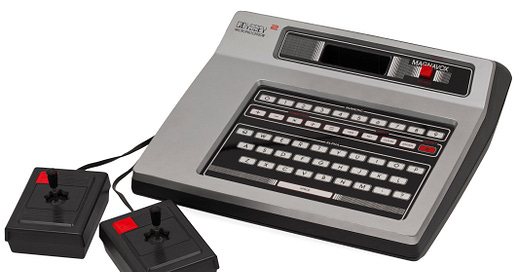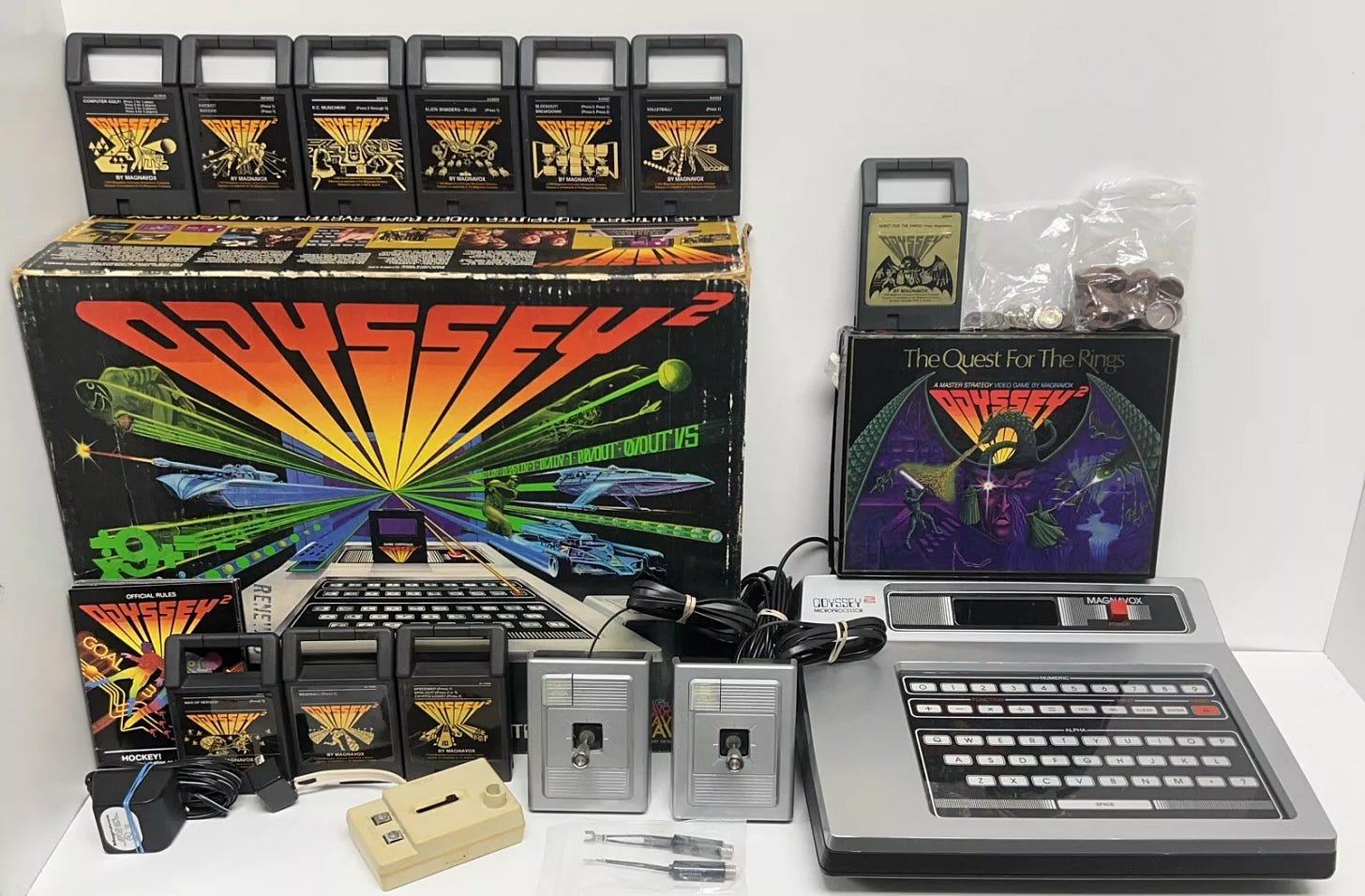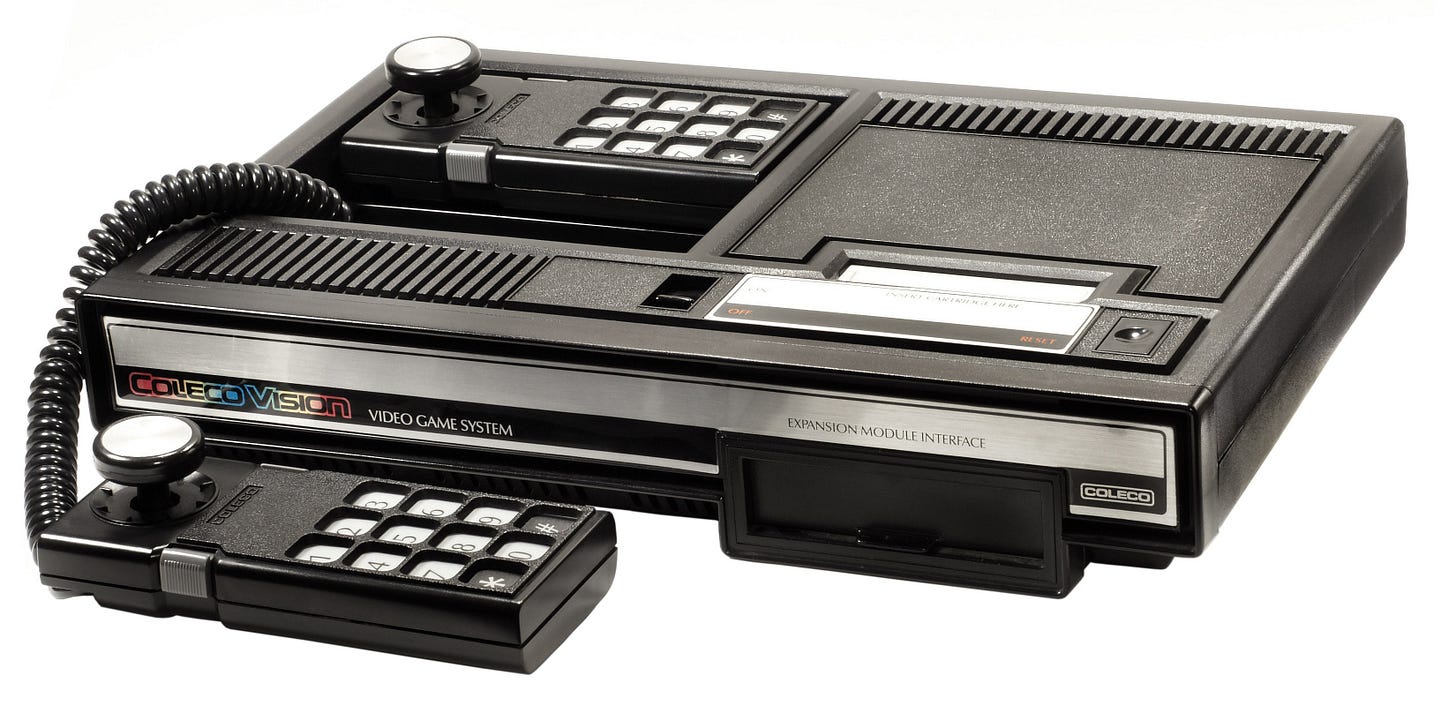When my family moved from Iran to America in the late 70s, everything felt new, unfamiliar, and a bit overwhelming. By 1980, we settled in Glendale, California, where my parents made one of their first American purchases for my brother and me: a Magnavox Odyssey. In a time when we were adjusting to a new culture and language, that Odyssey console became more than just a piece of technology; it was a gateway to discovery, fun, and a connection to a world that felt thrilling and boundless.
Our Odyssey came with several games, and I remember vividly those simple, pixelated shapes lighting up the screen, transformed by cardboard overlays into magical landscapes. Curious to revisit these early experiences, I did some research online to uncover which games we might have played. Table Tennis, likely one of the first, involved two white paddles and a small dot representing a ball. Though minimalistic, it had us laughing for hours, trying to outwit each other as we adjusted dials to move our “paddles” up and down. We also played Simon Says, a game that challenged our reflexes as we tried to match movements on screen. Haunted House required us to place a colorful overlay on the TV, turning simple lines and squares into a spooky mansion where we’d navigate a figure through ghostly rooms. With Ski, we became tiny skiers racing down the slopes—though in reality, it was more of a moving dot maneuvered by our imaginations.
These moments with the Odyssey left an enduring mark on my childhood. The games may have been simple, but they fostered laughter, competition, and family bonding, giving us a sense of normalcy in a time of transition. That cherished memory of family fun and early gaming magic is one I hold dear to this day.
Now, let’s explore what the Magnavox Odyssey represented, how it compared to other notable consoles like Atari, Intellivision, and ColecoVision, and how it sparked the beginning of a revolutionary industry.
The Odyssey’s Innovations and Limitations
The Magnavox Odyssey was an analog console that relied on circuitry rather than a microprocessor, setting it apart from later consoles that utilized digital computing technology. The Odyssey displayed simple monochrome visuals consisting of white blocks and lines on the screen. To enhance gameplay, users placed physical, translucent overlays on their TV screens, which provided background visuals and color to match the gameplay. The console featured a series of cartridges, though these were essentially different arrangements of circuitry rather than the more advanced ROM-based cartridges that came later. With games like Table Tennis, Ski, and Simon Says, the Odyssey introduced players to interactive electronic entertainment but required them to track scores manually and often lacked sound, color, and other audiovisual effects.
Despite these limitations, the Odyssey was a landmark innovation. It introduced basic game mechanics that would become the building blocks of the gaming industry, including controllers, different types of gameplay, and the concept of console-specific games. It also established the commercial potential of home gaming, which encouraged other companies to enter the market.
Atari and the Rise of Digital Console Gaming
In 1977, five years after the Odyssey’s release, Atari launched the Atari 2600, one of the most influential consoles in gaming history. Unlike the Odyssey, the Atari 2600 used a microprocessor and ROM cartridges, which allowed for greater diversity and complexity in games. The 2600’s games featured improved graphics, color, sound, and a wider range of interactivity than the Odyssey. Games like Space Invaders, Asteroids, and Adventure became cultural icons and helped to popularize the idea of home gaming as more than a novelty.
While the Odyssey introduced the console concept, Atari took it to the next level by focusing on more dynamic gameplay and pushing for widespread commercial success. The Atari 2600 became a household name and set a new standard in the market, leaving the Odyssey to be remembered as a historical artifact rather than a current competitor.
Intellivision: A Step Toward Complexity
In 1980, Mattel Electronics released the Intellivision console as a direct competitor to the Atari 2600. With improved graphics, more advanced sound, and complex gameplay options, the Intellivision aimed to provide a richer gaming experience. The console’s most significant feature was its unique controller, which had a 12-button keypad and a directional disc, allowing for more intricate control over gameplay than the simple joystick of the Atari 2600.
Intellivision was notable for its attempts to replicate sports games and other genres with greater fidelity to real-world mechanics, but it faced limitations in reaching the same level of popularity as the Atari 2600. However, it marked the beginning of more complex gaming experiences, with games like Advanced Dungeons & Dragons introducing fantasy.
ColecoVision: Pushing Arcade Quality at Home
Released in 1982, ColecoVision continued the trend of improving gaming technology by offering graphics and gameplay closer to what players experienced in arcades. With games like Donkey Kong and Zaxxon, the ColecoVision appealed to an audience that was familiar with and enjoyed the arcade experience. The console’s hardware was capable of more detailed sprites and smoother animations, setting it apart as one of the most advanced systems of its time.
ColecoVision also marked a shift in the industry, as third-party developers began to play a more prominent role in creating games. This console embraced the trend of arcade porting, which expanded the range of titles available to home users and further increased the appeal of console-based gaming.
Comparing the Odyssey to Later Consoles
When compared to the later consoles, the Magnavox Odyssey seems primitive, even archaic. It had no color, no sound, and relied on overlays and minimalistic visuals. Yet, without the Odyssey, it is unlikely that the industry would have developed as quickly or in the same way. Each subsequent console improved on the Odyssey’s basic framework: the Atari 2600 introduced digital processing and ROM cartridges, the Intellivision offered complex controls, and the ColecoVision brought arcade-level graphics and an extensive library of games.
While the Odyssey was limited in interactivity and visual appeal, it played a crucial role in establishing the foundation for home gaming. It was, quite literally, the starting point of an industry that would go on to reach incredible technological and cultural heights.
The Legacy of Console-Based Gaming
The Odyssey marked the birth of the console-based gaming industry, introducing players to the concept of home entertainment systems that connected to their television sets. Atari popularized it, Intellivision introduced greater complexity, and ColecoVision brought arcade graphics into the home. The trajectory from the Odyssey to the advanced systems of today shows an industry built on constant innovation, competition, and an ever-increasing demand for realism and engagement.
In summary, the Magnavox Odyssey may not be remembered for its sophistication, but its influence on gaming is undeniable. By opening the door to interactive home entertainment, it paved the way for Atari, Intellivision, ColecoVision, and beyond. These early consoles helped define what gaming could be, transforming it from a novel pastime into a cultural and technological phenomenon that continues to evolve. The Odyssey’s simplicity contrasts sharply with modern consoles, but it stands as a testament to the ingenuity and pioneering spirit that sparked a new form of entertainment—one that would go on to become a multi-billion-dollar industry with global appeal.









